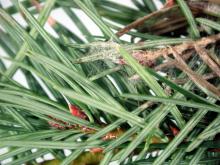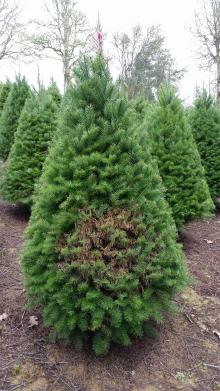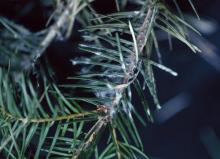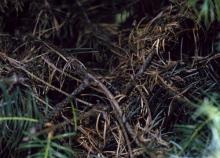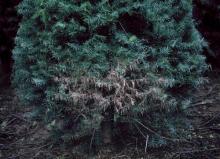Cause A binucleate Rhizoctonia-like fungus, but not the same one that causes root rot or damping-off of seedlings. The disease affects grand, noble, and Douglas-fir. Concerns about the disease in western Hemlock increased substantially in 2019. Some studies have shown balsam fir and Sitka spruce may also be susceptible. The disease is worse in Christmas tree plantations with restricted air flow, close tree spacing, and dense foliage. Although the Rhizoctonia-like fungus can infect needles of all ages, new infections are typically seen only on current year needles. This needle blight has been found in native Douglas-fir trees bordering Christmas tree plantations. Infected needles are thought to be blown onto healthy trees where the fungus colonizes healthy needles during the rainy season. Disease severity and symptom development are related to drought conditions.
Symptoms The disease usually is first noticed as browning of outer foliage in a roughly circular area. Browned areas can be anywhere on the tree but most often are on lower branches. Affected needles turn brown without any associated yellowing or banding. Needles hang down and stay attached to the branches long after they have died. Under moist conditions, fine fungal webbing may be visible, binding together the discolored needles. Buds and twigs of grand fir are killed but not those of Douglas-fir. The disease, which can spread to affect as much as half the side of a tree, can be distinguished from Botrytis (gray mold) in that the latter affects only current-year needles and shoots.
Cultural control
- Avoid planting in low-lying areas with poor air drainage.
- Space plants for good air circulation.
- Avoid planting near native stands of Douglas-fir that appear to have this disease.
- Control weeds around the bases of trees to improve air circulation.
- Pruning low in trees that have the disease only in the lower branches may allow harvest at some future date.
- Scout trees before the first shearing of the year. Look for areas of dead needles on the periphery of the tree. Remove and destroy affected trees.
Chemical control Tactics have not been developed to control this disease.
- Affirm WDG at 0.25 to 0.5 lb/100 gal water. Group 19 fungicide. 4-hr reentry.
- Bravo products used for Swiss needle cast may still result in losses from this disease. However, laboratory studies have shown some symptom suppression when Bravo 720 was used before inoculation.
- Medallion WDG: Although fir is not listed on the label, if not phytotoxic, it can be legally used. It has shown some symptom suppression when used before inoculation in the laboratory. Group 12 fungicide.
- ProStar 70 WG at 3 to 12 oz/100 gal water. Registered for evergreen trees grown in greenhouse, or outdoor container, or field nursery. Group 7 fungicide. 12-hr reentry.
Reference Putnam, M.L. 1999. A new foliar blight of Douglas, grand and noble fir caused by a binucleate Rhizoctonia-like fungus. Plant Disease 83:200.


